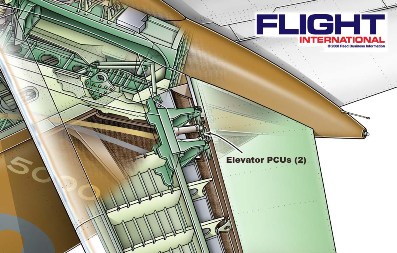Bombardier says one-third of its 147 Global XRS and Global 5000 super-large business jets have been given a clean bill of health following an emergency airworthiness directive (AD) issued by Transport Canada on 9 October. The mandate came after mechanics working on an aircraft discovered a seized bearing and fractured bolt in the mechanism that connects the elevator power control unit (PCU) to the elevator.
Additional inspections revealed two additional seized bearings on different aircraft, but no fractured bolts. Each side of the independently actuated elevator panels is driven by two PCUs connected to the panels via a pushrod and bearing/bushing/bracket assembly, with two bolts securing the elements together. Failure of the four bolts on either side of the T-tail elevator “could result in disconnection of the elevator control surface which would lead to flutter and loss of the aircraft,” Transport

“We were informed by a customer that there was a fractured bolt on one of their PCUs,” a Bombardier spokesman tells Flight International. “As a precautionary measure, we investigated.” Bombardier informed Transport

The US Federal Aviation Administration will likely issue a similar if not identical AD, though officials as of 16 October had not yet acted. The European Aviation Safety Agency and the Australian aviation authorities had both published emergency ADs following Transport
The AD calls for inspecting and lubricating the PCU attach joints of the affected aircraft, those with certain actuators that have accumulated more than 1,000h flight time, as called out in a 2 October service bulletin issued by Bombardier. Inspection intervals begin at 10 flight cycles or 50h of flight time downstream of the 13 October effective date of the mandate.
Bombardier says the issue is not design flaw “per se”, and officials had been in the process of modifying maintenance protocols to include lubricating the bearings when the in-service fracture occurred. The airframer had also switched to an “improved unit” that is better lubricated for production aircraft several months ago. The spokesman says Bombardier will pay to replace units that are found with chafing, bending or seizing.
Source: FlightGlobal.com
















